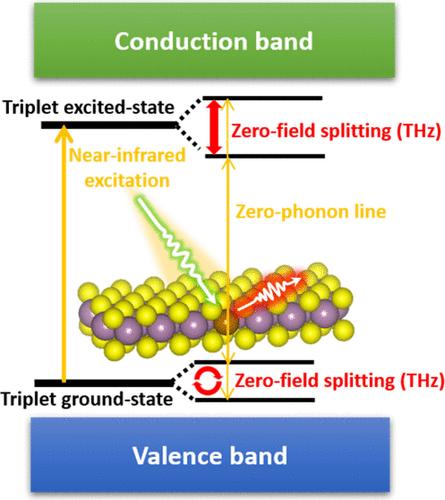Quantum Defects in 2D Transition Metal Dichalcogenides for Terahertz Technologies
IF 16
1区 材料科学
Q1 CHEMISTRY, MULTIDISCIPLINARY
引用次数: 0
Abstract
Substitutional transition metal (TM) point defects have recently been controllably introduced in two-dimensional (2D) transition metal dichalcogenides. We identify quantum defect candidates through a first-principles materials discovery approach with 25 TM elements substituting Mo and W in 2D MoS2 and WSe2, respectively. We elucidate trends in the charge transition levels for these 50 systems and report the existence of defects with spin-triplet ground states and a zero-field splitting (ZFS) in the terahertz (THz) regime, in contrast to typical gigahertz values. These defects can couple to resonant near-infrared radiation, providing a route to applications as high-fidelity qubits controlled by spin-dependent optical transitions. The THz ZFS implies that these high-fidelity operations can take place at higher temperatures compared to the case for GHz qubits. Our results also point toward the possibility of realizing a single-photon THz emitter. This work broadens the scope of quantum defects, highlighting the opportunities for next-generation THz quantum technologies─an area of growing interest given the rapid advancement in the development of THz sources and detectors.

太赫兹技术中二维过渡金属二硫族化合物的量子缺陷
取代过渡金属(TM)点缺陷最近被可控地引入到二维(2D)过渡金属二硫族化合物中。我们通过第一性原理材料发现方法确定了量子缺陷候选者,其中25个TM元素分别取代了二维MoS2和WSe2中的Mo和W。我们阐明了这50个系统的电荷跃迁水平的趋势,并报告了与典型的千兆赫值相比,在太赫兹(THz)区域存在自旋三重态基态缺陷和零场分裂(ZFS)。这些缺陷可以耦合到共振近红外辐射,为由自旋相关光学跃迁控制的高保真量子比特提供了一条应用途径。太赫兹ZFS意味着,与GHz量子位相比,这些高保真操作可以在更高的温度下进行。我们的结果也指向了实现单光子太赫兹发射器的可能性。这项工作拓宽了量子缺陷的范围,突出了下一代太赫兹量子技术的机会──鉴于太赫兹源和探测器的快速发展,这是一个越来越受关注的领域。
本文章由计算机程序翻译,如有差异,请以英文原文为准。
求助全文
约1分钟内获得全文
求助全文
来源期刊

ACS Nano
工程技术-材料科学:综合
CiteScore
26.00
自引率
4.10%
发文量
1627
审稿时长
1.7 months
期刊介绍:
ACS Nano, published monthly, serves as an international forum for comprehensive articles on nanoscience and nanotechnology research at the intersections of chemistry, biology, materials science, physics, and engineering. The journal fosters communication among scientists in these communities, facilitating collaboration, new research opportunities, and advancements through discoveries. ACS Nano covers synthesis, assembly, characterization, theory, and simulation of nanostructures, nanobiotechnology, nanofabrication, methods and tools for nanoscience and nanotechnology, and self- and directed-assembly. Alongside original research articles, it offers thorough reviews, perspectives on cutting-edge research, and discussions envisioning the future of nanoscience and nanotechnology.
 求助内容:
求助内容: 应助结果提醒方式:
应助结果提醒方式:


